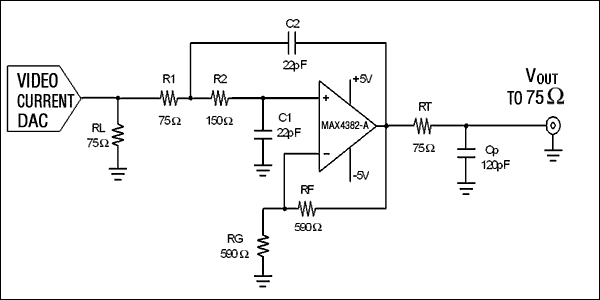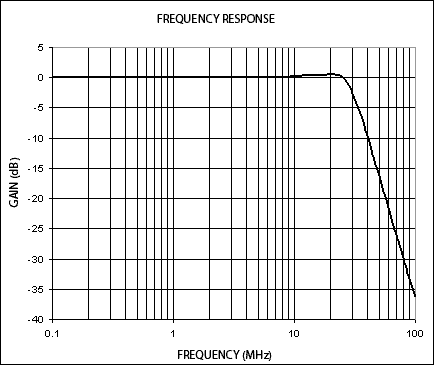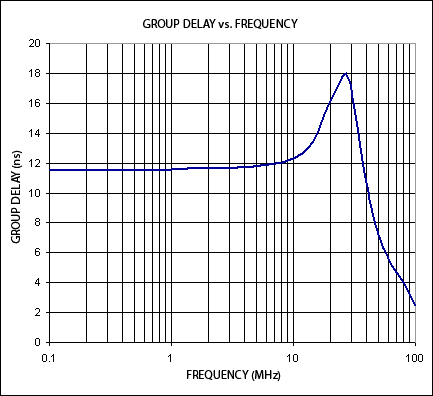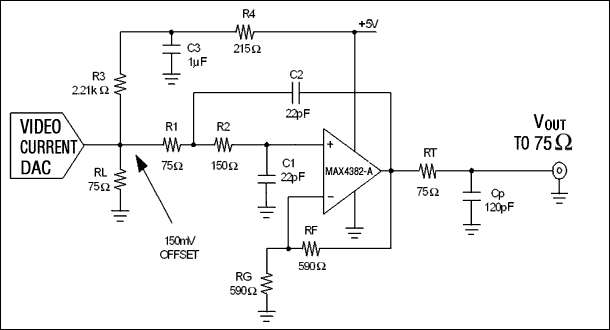Abstract: This application note describes how to use the MAX4382 3-channel amplifier to build a low-cost, three-channel, three-pole, low-pass Sallen-Key filter with dual power supplies. This circuit provides Butterworth filter frequency response characteristics, with a 30MHz bandwidth, very suitable for video reconstruction filtering in HDTV applications. The MAX4382 can provide the same filtering characteristics as a dual-supply configuration through an input bias network when powered by a single supply.
In HDTV applications, a low-pass filter is used to restore RGB and composite video (Y, Pb, Pr) signals. The filter is placed in the post-stage of the video DAC to eliminate high-order harmonics in the signal. It can also be placed in the ADC Front, used for anti-alias filtering. The MAX4382 high-speed, three-channel amplifier can be used to construct such a low-pass filter, which is ideal for HDTV applications.
Figure 1 shows the typical circuit of one channel of the MAX4382 when it is powered by dual power supplies. It is a three-pole, three-pole, Sallen-Key, Butterworth low-pass filter. In the figure, the current output DAC generates a video signal and the resistance ( RL) is used to set the amplifier signal amplitude. The MAX4382, RL, R1, R2, C1, and C2 form a two-pole, Sallen-Key low-pass filter with a gain of 2. The output drives a 75Ω load, and RT and Cp form a real pole. The -3dB bandwidth of the circuit shown in Figure 1 is approximately 30MHz (see Figure 2). The 44.25MHz frequency provides approximately 14dB of attenuation; the 74.25MHz frequency provides approximately 28dB of attenuation. The group delay is about 6.5ns (see Figure 3). If the current output DAC load is not 75Ω, just use the following relationship to set R1: R1 + RL = 150Ω. When RL is greater than 150Ω, C1, C2, R1 and R2 need to be adjusted.

Figure 1. Three-pole, Sallen-Key, Butterworth low-pass filter constructed with MAX4382

Figure 2. Correspondence between circuit gain and frequency

Figure 3. Correspondence between circuit group delay and frequency
When using a 5V single power supply, the standard video signal range is 0V to 1V. A DC bias needs to be added to the input of the MAX4382 to prevent the video signal from being clamped at the output of the amplifier. Figure 4 shows the input bias network of a channel. R3, R4, and C3 together with RL generate a 150mV DC bias at the input. The output DC level of the amplifier is 300mV, which is enough to ensure that the output stage works in the linear region. R4 and C3 help to eliminate power supply noise, and the filtering characteristics are the same as the dual power supply configuration.

Figure 4. MAX4382 input bias network for one channel
In HDTV applications, a low-pass filter is used to restore RGB and composite video (Y, Pb, Pr) signals. The filter is placed in the post-stage of the video DAC to eliminate high-order harmonics in the signal. It can also be placed in the ADC Front, used for anti-alias filtering. The MAX4382 high-speed, three-channel amplifier can be used to construct such a low-pass filter, which is ideal for HDTV applications.
Figure 1 shows the typical circuit of one channel of the MAX4382 when it is powered by dual power supplies. It is a three-pole, three-pole, Sallen-Key, Butterworth low-pass filter. In the figure, the current output DAC generates a video signal and the resistance ( RL) is used to set the amplifier signal amplitude. The MAX4382, RL, R1, R2, C1, and C2 form a two-pole, Sallen-Key low-pass filter with a gain of 2. The output drives a 75Ω load, and RT and Cp form a real pole. The -3dB bandwidth of the circuit shown in Figure 1 is approximately 30MHz (see Figure 2). The 44.25MHz frequency provides approximately 14dB of attenuation; the 74.25MHz frequency provides approximately 28dB of attenuation. The group delay is about 6.5ns (see Figure 3). If the current output DAC load is not 75Ω, just use the following relationship to set R1: R1 + RL = 150Ω. When RL is greater than 150Ω, C1, C2, R1 and R2 need to be adjusted.

Figure 1. Three-pole, Sallen-Key, Butterworth low-pass filter constructed with MAX4382

Figure 2. Correspondence between circuit gain and frequency

Figure 3. Correspondence between circuit group delay and frequency
When using a 5V single power supply, the standard video signal range is 0V to 1V. A DC bias needs to be added to the input of the MAX4382 to prevent the video signal from being clamped at the output of the amplifier. Figure 4 shows the input bias network of a channel. R3, R4, and C3 together with RL generate a 150mV DC bias at the input. The output DC level of the amplifier is 300mV, which is enough to ensure that the output stage works in the linear region. R4 and C3 help to eliminate power supply noise, and the filtering characteristics are the same as the dual power supply configuration.

Figure 4. MAX4382 input bias network for one channel
6 Blade Ceiling Fan,Six Blades Ceiling Fan,Ceiling Fans With Remote,Six Blade Ceiling Fan
Jiangmen MagicPower Electrical Appliances Co.,Ltd. , https://www.magicpowerfan.com